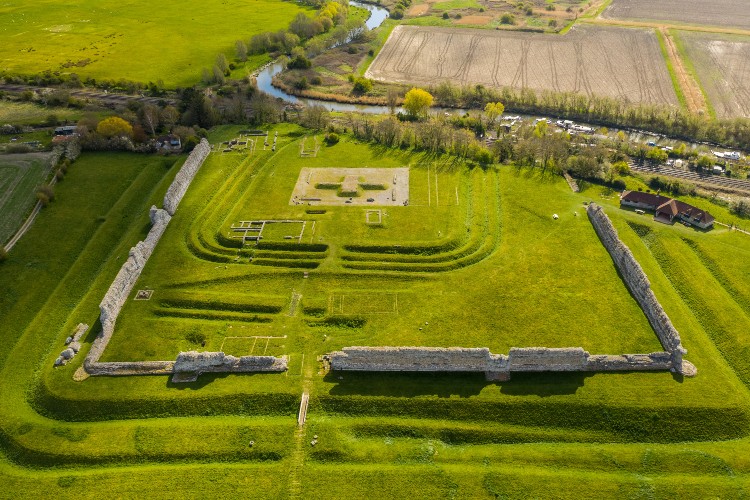Roman Kent: The Foundation of Cantium

For nearly four centuries, from AD 43 to around 410, Kent stood as a crucial province within the vast Roman Empire. Known to the Romans as 'Cantium', the region's strategic position made it the gateway to Britain and the Empire's most vital link to the continent. The legacy of Roman Kent remains etched into the landscape today, from the impressive ruins of Richborough Roman Fort to the grid pattern of Canterbury's streets and the remarkable villa remains that continue to emerge from Kent's fertile soil.
When exploring Roman Kent, we embark on a journey that reveals how a conquered territory became a sophisticated Roman province with urban centres, grand villas, spiritual sanctuaries, and a complex infrastructure that would shape the region's development for millennia to come. This exploration tells a story not simply of conquest but of cultural transformation, as native Britons and Roman colonists forged a distinctive Romano-British society in the Garden of England.
The Roman Conquest: Invasion at Richborough
The Roman conquest of Britain began on Kent's shores in AD 43, when Emperor Claudius dispatched four legions under the command of Aulus Plautius. Though Julius Caesar had landed in Kent twice before in 55-54 BC, these earlier expeditions were brief demonstrations of Roman power rather than true conquest attempts.
Richborough (Rutupiae): Gateway to Roman Britain
Richborough Roman Fort in Kent is perhaps the most symbolically important Roman site in Britain, marking the starting point of the successful Roman conquest that would last nearly four centuries. Initially an invasion beach and supply base, it later developed into a thriving civilian settlement with monumental architecture before being fortified as a Saxon Shore fort in the late 3rd century.
Archaeological evidence suggests that the main invasion force landed at Richborough (Rutupiae) on the Isle of Thanet, which was then separated from the mainland by the Wantsum Channel. The natural harbour provided an ideal landing site, and the Romans quickly established a beachhead. The significance of Richborough cannot be overstatedâit was here that Roman Britain began, with the establishment of a supply base that would support the advancing legions.

Within decades, Richborough had evolved from a military landing site to an impressive entry point to the province, marked by a monumental quadrifons triumphal arch that stood some 25 metres tall. This arch, whose massive concrete foundations can still be seen today, announced to visitors that they were entering a province firmly under Roman control. It would have been visible for miles, both from sea and land, and likely served as both a navigation marker and a powerful symbol of Roman authority.
Roman Urban Centres in Kent
As Roman rule stabilised, several key urban settlements emerged across Kent. Canterbury (Durovernum Cantiacorum) became the civitas capitalâthe administrative centre for the regionâwhile Rochester (Durobrivae) and Dover (Dubris) developed as important settlements along Watling Street, the major Roman road linking the coast to London (Londinium) and beyond.
Canterbury: The Capital of Cantium
Canterbury's development as the primary Roman urban centre in Kent built upon its significance as a pre-Roman settlement. Excavations beneath modern Canterbury have revealed an impressive town that followed the classic Roman grid pattern, with streets intersecting at right angles. The town boasted stone public buildings, including a theatre that could seat several thousand spectators, public baths, temples, and a forum-basilica complex that served as the commercial and administrative heart of the settlement.
Visitors to Canterbury today can still experience this Roman heritage at the Canterbury Roman Museum, built around the remains of a Roman townhouse with remarkable mosaic floors. The museum displays numerous artefacts that offer glimpses into daily Roman life in the town, from jewellery and household items to tools and religious offerings.
Rochester and Dover: Strategic Settlements
Rochester developed as an important river crossing on the Medway, with a bridge and small fort guarding this strategic point on Watling Street. While less extensive than Canterbury, Rochester nevertheless had stone walls, public buildings, and residential areas.
At Dover, the Romans built one of Britain's most important ports, protected by a fort and complemented by the imposing lighthouse known as the 'Pharos' that still stands within the grounds of Dover Castle. This lighthouse, one of the tallest surviving Roman structures in Britain, guided ships into the harbour and demonstrates the sophistication of Roman maritime infrastructure.
Country Estates: Roman Villas in Kent
Beyond the urban centres, the Kentish countryside was dotted with Roman villasâcountry estates that combined agricultural production with luxurious living. Kent's fertile soil and gentle climate made it ideal for farming, and the province became an important producer of grain, fruit, and other agricultural products for the Empire.
The most spectacular villa remains in Kent can be found at Lullingstone, near Eynsford. This remarkable site, now preserved by English Heritage, offers a window into the opulent lifestyle of wealthy Romano-British landowners. Built in the 1st century AD and continuously modified and extended until the late 4th century, the villa features stunning mosaic floors, a private bath suite, and a rare house-church with early Christian wall paintings.

Other significant villas have been discovered throughout the county, including sites at Eccles, Darenth, and Folkestone. These ranged from modest farmhouses to elaborate complexes rivalling urban dwellings in their sophistication. The distribution of these villas across Kent demonstrates how thoroughly Romanised the landscape had become, with the countryside being shaped by Roman agricultural practices, architectural styles, and cultural influences.
Infrastructure and Communications
The Romans transformed Kent's landscape with an impressive network of roads, bridges, and ports that connected the region internally and linked it to the wider Empire. Watling Street, the principal Roman road in Kent, ran from Richborough through Canterbury and Rochester to London, forming part of the main route between the coast and the provincial capital. Sections of this ancient road still underlie the modern A2 and A207.
Roman Invasion
Emperor Claudius orders the invasion of Britain. Roman forces land at Richborough (Rutupiae) in Kent.
Urban Development
Early development of Canterbury (Durovernum Cantiacorum) as the civitas capital of the Cantiaci tribe.
Road Network
Construction of major roads including Watling Street, linking key settlements in Kent to London.
Villa Economy
Proliferation of rural villas across Kent as the region becomes increasingly prosperous and Romanised.
Saxon Shore Forts
Construction of coastal fortifications including Richborough, Reculver, and Dover as part of the Saxon Shore defence system.
End of Roman Rule
Roman administration withdraws from Britain, marking the end of the formal Roman period in Kent.
Secondary routes branched from this main artery, connecting smaller settlements, villas, and industrial sites across the county. The road network facilitated the movement of troops, officials, traders, and goods, and played a crucial role in the economic integration of Kent into the wider provincial economy.
The Romans also made extensive use of Kent's rivers and coastline for transport and trade. Beyond the major port at Dover, smaller harbours existed at Richborough, Reculver, and other coastal locations. These formed part of a maritime network that connected Kent to continental Europe and provided vital supply routes for the province.
Religion and Culture in Roman Kent
The religious landscape of Roman Kent reflected the cultural fusion that characterised the province. Traditional Roman deities were worshipped alongside local British gods and imported eastern cults. Temples and shrines have been identified at several locations, including Canterbury, where a temple dedicated to Apollo has been excavated, and Worth, near Sandwich, which featured a significant religious complex.
Perhaps the most fascinating religious site in Roman Kent is the temple complex at Springhead (Vagniacae), near Gravesend. Here, archaeologists have uncovered a series of temples and ritual structures centred around the springs that gave the settlement its name. The site demonstrates the importance of water in Romano-British religion, with offerings thrown into the sacred springs as part of religious rituals.
By the late Roman period, Christianity was making inroads into Kent. The house-church at Lullingstone Villa, with its wall paintings featuring Chi-Rho symbols (representing Christ) dating from the mid-4th century, provides some of Britain's earliest evidence of Christian worship. This religious shift would become increasingly significant as the Roman era drew to a close.
The End of Roman Kent and Its Legacy
Roman rule in Britain began to weaken in the late 4th century. The construction of the Saxon Shore fortsâa series of coastal fortifications including those at Richborough, Reculver, and Doverâreflects the growing concern about raids from across the North Sea. These impressive structures, with their distinctive rounded bastions and thick walls, represent Rome's final major building projects in Kent.
By 410 AD, with the Empire under pressure on multiple fronts, Roman troops were formally withdrawn from Britain. The transition away from Roman rule was likely gradual rather than abrupt in Kent, with some Romano-British institutions and practices continuing for decades. Archaeological evidence suggests that some villas remained occupied into the 5th century, and certain aspects of Roman material culture persisted.
The Roman legacy in Kent is profound and enduring. The county's settlement pattern, with Canterbury as its principal city and Rochester as a secondary centre, originated in the Roman period. Major routeways established by the Romans continue to shape modern transport networks. Even the agricultural landscape bears the imprint of Roman field systems and farming practices.
Roman Sites to Visit in Kent
- Richborough Roman Fort (English Heritage) - The site where the Romans first landed, featuring impressive ruins and a museum.
- Canterbury Roman Museum - Built around the remains of a Roman townhouse with impressive mosaic floors.
- Lullingstone Roman Villa (English Heritage) - One of Britain's finest villa sites with spectacular mosaics and a rare house-church.
- Dover Roman Painted House - Remains of a Roman mansion with unique painted walls.
- The Roman Lighthouse (Pharos) at Dover Castle - One of the tallest surviving Roman structures in Britain.
Perhaps most significantly, the Romans established Kent as the gateway to Britainâa role that the county would continue to play throughout history. When Christianity returned to England with St Augustine in 597 AD (as explored in our Anglo-Saxon Heritage section), it was no coincidence that he landed in Kent, following in the footsteps of the Roman missionaries who had come before him.
The archaeological legacy of Roman Kent continues to grow as new discoveries are made. Recent excavations at Teynham revealed a previously unknown Roman mausoleum with a statue of Triton, while development-led archaeology in advance of infrastructure projects regularly uncovers new evidence of Roman settlement and activity. Each discovery adds another piece to our understanding of this foundational period in Kent's history.
Today, visitors to Kent can explore numerous Roman sites, from the impressive ruins of Richborough to the wonderfully preserved villa at Lullingstone. Museums in Canterbury, Dover, and Maidstone house significant collections of Roman artefacts that provide tangible connections to this distant era. Through these remains, we can glimpse the lives of the people who lived in Cantium nearly two millennia agoâthe soldiers, administrators, merchants, farmers, and craftspeople who made Kent their home during the four centuries of Roman rule.
Further Reading and Resources
For those interested in delving deeper into Roman Kent, we recommend visiting our Archaeological Sites page for more information on excavations and discoveries across the county. Our Research Resources section provides guidance on accessing archives and publications related to Roman Kent.
The legacy of Roman infrastructure can also be traced through our Historic Towns & Villages section, which examines how Roman foundations influenced later settlement patterns, while the Kent Churches & Cathedrals page explores how early Christianity emerged during the late Roman period.
